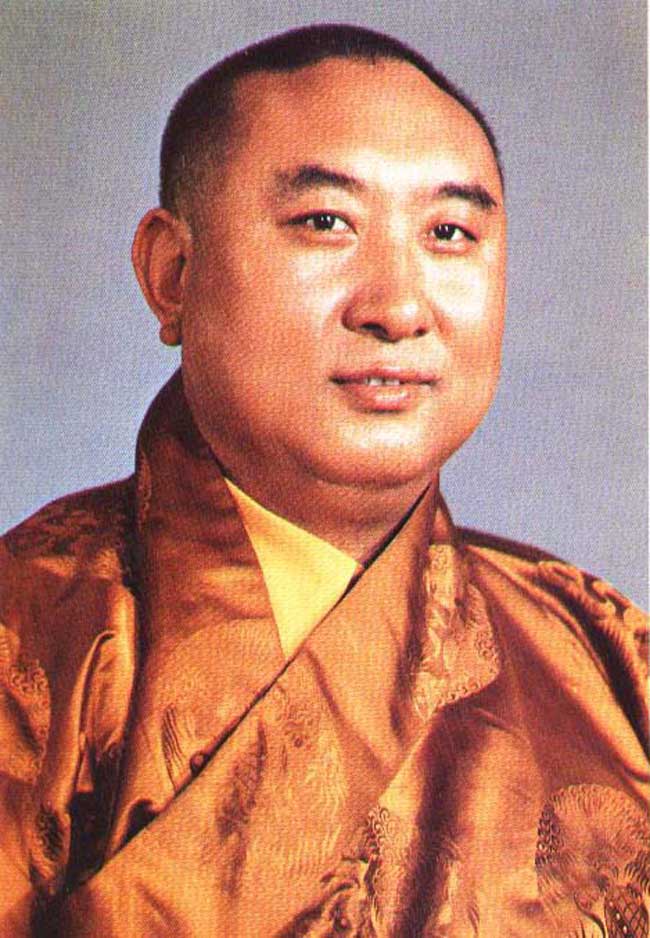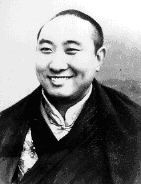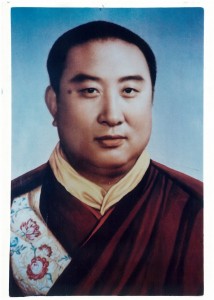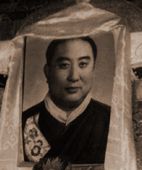
The 10th Panchen Lama, Lobsang Trinley Lhündrub Chökyi Gyaltsen
The first Panchen (“great scholar”) Lama, the abbot of Tashilhunpo Monastery, was given the title by the Great Fifth, who wished to honor his tutor. Subsequent Panchen Lamas did not have such amiable relationships with the Dalai Lamas and the occupying Chinese have attempted to use this rivalry to their advantage. The Ninth Panchen Lama (1883-1937) fled to Mongolia after a dispute with the Thirteenth Dalai Lama over taxes.
The 10th Panchen Lama was born on February 19, 1938 in today’s Xunhua Salar Autonomous County of Qinghai, to Gonpo Tseten and Sonam Drolma and given the name Gonpo Tseten, the same as his father. He was recognized as the reincarnation of 9th Panchen Lama by Flak Lakho Rinpoche, and in 1951 was confirmed by the 14th Dalai Lama as the 10th Panchen Lama. In 1952 he met Dalai Lama in Lhasa and then took up his seat in Tashi Lhunpo Monastery in Shigatse, Tibet.
He was enthroned on June 11, 1949 in Amdo (Qinghai) under the auspice of Chinese officials after the Kuomintang administration approved the selection. (He was not recognised by the Dalai Lama, because the Panchen’s retinue refused to bring him to Lhasa and submit him to traditional tests.) At this time, he supported China’s claim of sovereignty over Tibet, and China’s reform policies for Tibet.
In 1951, he was invited to Beijing at the time of the arrival of a Tibetan delegation which was finally forced to sign the 17-Point Agreement and was forced to send a telegram requesting the Dalai Lama, to implement the Agreement. He was recognized by the 14th Dalai Lama, Tenzin Gyatso when they met in 1952.

In September 1954, the Dalai Lama and the Panchen Lama went to Beijing to attend the first session of the first National People’s Congress, meeting Mao Zedong and other leaders. The Panchen Lama was soon selected as a member of the Standing Committee of the National People’s Congress and in December 1954 he became the deputy chairman of the Chinese People’s Political Consultative Conference.
In 1956, the Panchen Lama went to India on a pilgrimage together with the Dalai Lama. When the Dalai Lama fled to India in 1959, the Panchen Lama publicly supported the Chinese government, and the Chinese brought him to Lhasa and made him chairman of the Preparatory Committee for the Tibet Autonomous Region.
Even after the 14th Dalai Lama fled to India during the 1959 upheaval in Tibet, the 10th Panchen Lama, then 21-years-old, decided to stay in Tibet. Some say that he collaborated with the Chinese government. However, by the early 1960s, he observed that the Chinese policies at work in Tibet were resulting in hunger, death and suffering for the Tibetan people. After a tour through Tibet, in May 1962, he met Zhou Enlai to discuss a petition he had written, criticizing the situation in Tibet. The report became known as the ’70,000 Character Petition’. The petition was a 70,000 character document that dealt with the brutal suppression of the Tibetan people during and after the Chinese invasion of Tibet. The initial reaction was positive, but in October 1962, the PRC authorities dealing with the population criticized the petition. Chairman Mao called the petition “… a poisoned arrow shot at the Party by reactionary feudal overlords.”
Believed to be the most extensive internal criticism of Chinese Communist policies ever submitted to the leadership, it documents the mass arrests, excessive punishment and executions of Tibetans that followed the 1959 Uprising in Tibet against Chinese rule, and the starvation in Eastern Tibet that resulted from policies implemented as part of Mao’s Great Leap Forward at the end of the 1950s. The 70,000 Character Petition remained secret for 34 years, seen only by those in inner Party circles in China.

The Chinese Government accused the Panchen Lama of being anti-Chinese and engaging in counter-revolutionary activities. In 1964, at a public meeting in Lhasa, he was removed from all public positions of authority. He was openly criticised and humiliated, and later taken to China. Condemned without trial as an “enemy of the Tibetan people”, he had his dream journal confiscated and used against him, and then imprisoned for nine years and eight months. He was 24 years old at the time.
The Panchen’s situation worsened when the Cultural Revolution began. The Chinese dissident and former Red Guard Wei Jingsheng published in March 1979 a letter under his name but written by another anonymous author, denouncing the inhuman conditions of the Chinese Qincheng Prison where the 10th Panchen Lama was imprisoned.
In October 1977, he was released but held under house arrest in Beijing until 1982. After his release, he was considered by the PRC authorities to be politically rehabilitated and he then rose to important positions. In the years that followed, he was an outspoken advocate of liberalisation laws and policies to ensure the survival of Tibetan culture and religion, returning to Tashilhunpo only in his final few years.
In 1979, Panchen Lama was appointed Deputy Chairman of the National People’s Politics Consultative Committee and deputy Chairman of the National Peoples Congress. He traveled widely in the Tibetan regions of Amdo and Kham. His message urged Tibetans to maintain good relations with the Chinese. He also strongly advised them to keep alive the spirit to”Be a Tibetan” and “Be for Tibetan cause”. In 1985, in the Monlam festival after the Tibetan New Year in Lhasa, The Panchen Lama said, “His Holiness the Dalai Lama and I are spiritual friends. There are no differences between His Holiness the Dalai Lama and me. Some people are trying to create discord between us. This will not succeed.” He also pushed for a law making Tibetan the official language of the Tibetan Autonomous Region; it was passed in 1987.

Early in 1989, the 10th Panchen Lama returned to Tibet for the first time in nearly three decades to reinter some of the recovered bones from the graves of the previous Panchen Lamas, graves that had been destroyed during the destruction of Tashilhunpo in 1959. He suddenly and unexpectedly died in Shigatse at the age of 51, on 28th January, three days after consecrating this stupa containing the remains of many of the past Panchen Lamas. The Tenth Panchen Lama was also interred in the tomb, which was completed in 1992.
Sources:
Tibet: A Virtual Field Trip by J.H. Wittke (http://oak.ucc.nau.edu/wittke/Tibet/Panchen.html)
The Official Website of Tashi Lhunpo Monastery (http://tashilhunpo.org/about)
Kotan.org (http://www.kotan.org/tibet/10th_panchen_lama.html [Editor's Note: This link appears to have been removed from the mentioned website])
Wikipedia (http://en.wikipedia.org/wiki/Choekyi_Gyaltsen)








































 English
English Indonesia
Indonesia Tibetan
Tibetan
Thupten Lhundrup
July 18, 2013
The name Panchen Lama spreads like wild fire in the huge continent of China from the high plateaus of Tibet all the way to China, Mongolia and even India. The great Panchen Lama for many life times now through his compassion and love for sentient beings during this degenerate age has manifested himself as a leader of a nation in order to help bring them hope and light in times of darkness.
Though we all know that the Panchen Lama has gone through tremendous discomfort to uphold the Buddha Dharma until today, we respect him for that because he is irreplaceable.